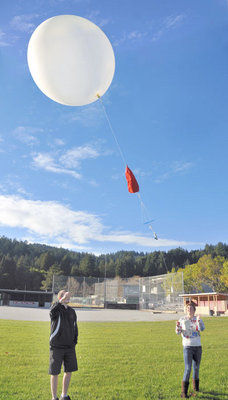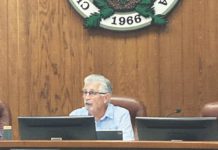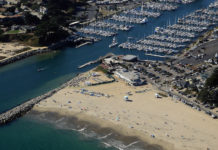
Since Thanksgiving, the softball field at San Lorenzo Valley High School has been a launching pad for two students conducting experiments to map the microclimate of the San Lorenzo Valley.
Three days a week, if it’s not raining, sophomores Connor Lydon and Natalie Gallagher release helium-filled weather balloons fitted with sensors, called radiosondes, that detect the air temperature, barometric pressure, wind speed, wind direction and humidity.
“We’ve been (launching) mornings and afternoons Mondays, Wednesdays and Fridays,” Gallagher said. “We’re looking for inversions and changes in the air.”
Inversions occur in the atmosphere when warm air meets cooler, denser air. In places like the San Lorenzo Valley, warm air rising over the cooler air can create a sort of lid that keeps cool air — and fog — trapped within geographical low points.
The project is part of Jane Orbuch’s environmental monitoring class, where they and 20 other students conduct research and collect data on topics of environmental concern over the course of the school year.
But Lydon and Gallagher are also working in partnership with the Monterey Bay Unified Air Pollution Control District, which hopes to gain a more accurate picture of air currents in the valley – because not only can inversion trap fog in the valley, it also can trap smoke.
Mike Gilroy, deputy air pollution control officer, praised the students and their research.
“This is not some little high school science project,” he said. “We really need this data.”
Orbuch explained that because of the bowl-like topography of the San Lorenzo Valley and the height of the Santa Cruz Mountains, the air district’s central climate profiling equipment in Moss Landing cannot take accurate readings of the area’s weather.
“The valley has this microclimate, and the profiler doesn’t know what’s going on below 5,000 feet,” she said. “Nobody really knows.”
According to Orbuch, air district representatives suggested a student-led weather balloon experiment during an environmental education fair several years ago at the Santa Cruz County Office of Education, and she “always wanted to do an air monitoring project.”
But Lydon and Gallagher were the first students to pursue the idea.
On their own initiative, Orbuch said, they sought out Gilroy during a July 4 pancake breakfast in Boulder Creek and convinced him to support the project.
“I thought, this sounds kind of interesting,” Lydon said. “It’s beneficial to us and to them.”
Lydon and Gallagher put together a research paper during the summer and spent the first half of the fall semester writing grant proposals, studying how to interpret the data they would be gathering and preparing to launch balloons. The first launch was at the end of November.
Lydon said he and Gallagher would be learning how to read data from Dr. Michael Loik, a professor of environmental studies at University of California, Santa Cruz, who is acting as their mentor.
When they launch a balloon, the pair records radiosonde readings and measurements between 310 feet above sea level — the school’s altitude — and 5,000 feet, Gallagher said.
Most monitoring groups in Orbuch’s class extend their studies over the course of the year. But Gallagher said there was a greater time crunch on her and Lydon, because winter is when wood smoke from heating and rubbish fires is most present, and smoke is at the center of their research.
“I would say our (project) is more time-consuming and condensed,” she said.
The San Lorenzo Valley, where burning of yard waste is common and many homes are heated by wood fires, tends to have abnormally high levels of smoke in the air, which can lead to respiratory issues. That has made the valley a focus of Monterey Bay Unified Air Pollution Control District efforts for the past several years.
With the district’s help, Gilroy said, Lydon and Gallagher have amassed close to $15,000 in grants and donations to procure weather balloons, radiosonde sensors, mounted sensors and computer programs to record the data transmitted from the balloons.
The donations — including nearly $10,000 from Grand Rapids, Mich.-based InterMet Systems — are essential, he said, as each launch costs about $250 and neither the balloon nor the radiosonde can be recovered after the experiment.
“Most universities don’t even get this stuff,” Gilroy said. “We’re getting real data that we will use.”
According to the students, the balloons continue to rise until they reach an altitude of about 50,000 feet, where they pop. The radiosonde, attached to a parachute, ends up somewhere in the Central Valley.
The data Gallagher and Lydon collect will be used to build a more accurate picture of the air currents and climate of the San Lorenzo Valley, which will help determine how much smoke particulate is in the air, as well as how long it remains in a given area.
Orbuch applauded Lydon and Gallagher for taking on a complex project and running with it.
“(When they started), they knew nothing about the atmosphere or inversion layers,” she said. “Now, they run the whole program — I just troubleshoot.”
To comment, email reporter Joe Shreve at jo*@*********er.com, call 438-2500 or post a comment at www.pressbanner.com.












